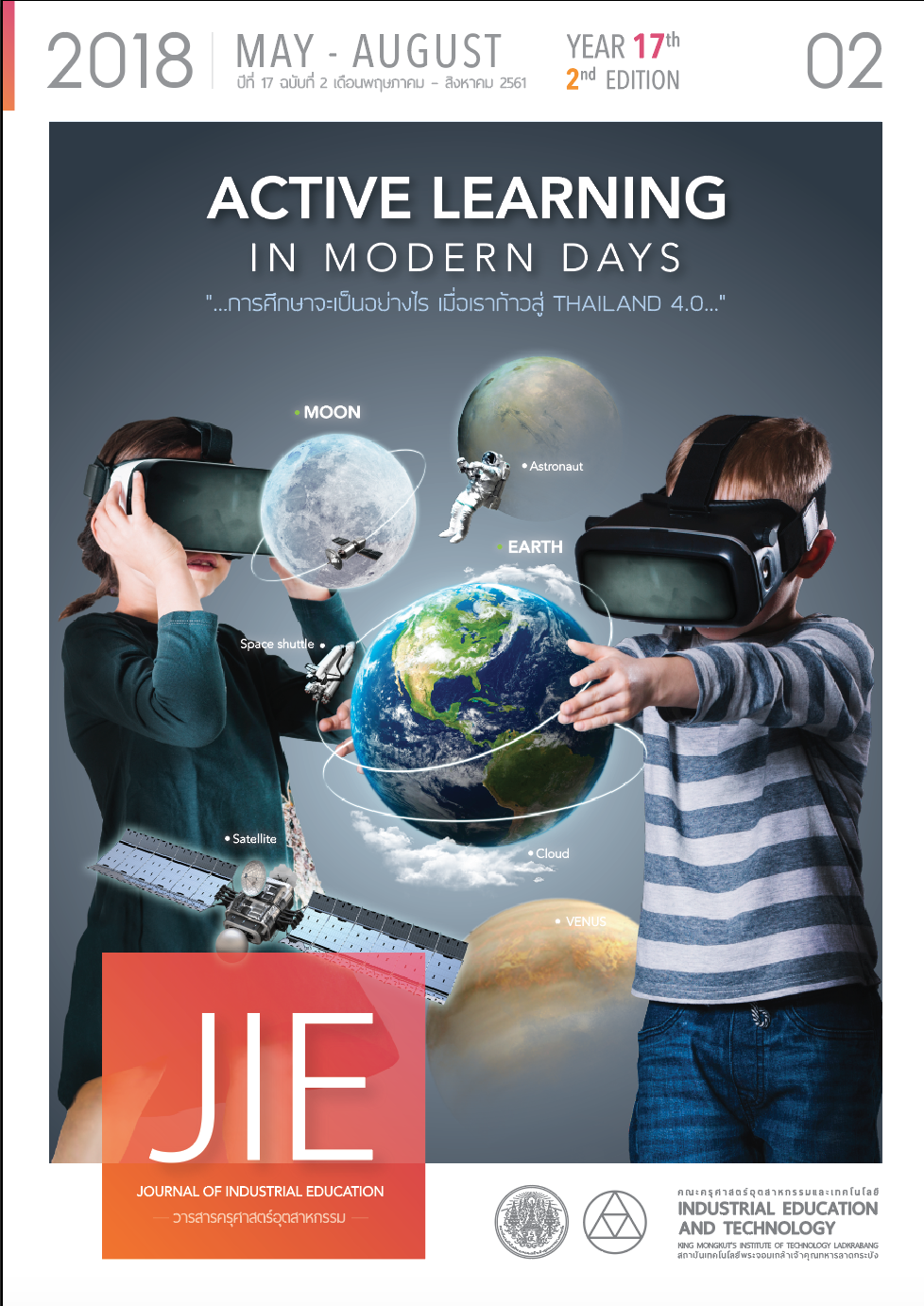การศึกษาข้อบกพร่องด้านความรู้เชิงมโนทัศน์และความรู้เชิงกระบวนการ เรื่องวิธีเรียงสับเปลี่ยน ของนักเรียนชั้นมัธยมศึกษาปีที่ 5
คำสำคัญ:
ข้อบกพร่องในวิชาคณิตศาสตร์ของนักเรียน, ความรู้เชิงมโนทัศน์, ความรู้เชิงกระบวนการ, วิธีเรียงสับเปลี่ยนบทคัดย่อ
การวิจัยนี้มีวัตถุประสงค์เพื่อศึกษาลักษณะข้อบกพร่องด้านความรู้เชิงมโนทัศน์และความรู้เชิงกระบวนการ เรื่องวิธีเรียงสับเปลี่ยน ของนักเรียนชั้นมัธยมศึกษาปีที่ 5 กลุ่มตัวอย่างที่ใช้ในการวิจัยเป็นนักเรียนชั้นมัธยมศึกษาปีที่ 5 ภาคเรียนที่ 2 ปีการศึกษา 2560 โรงเรียนด่านช้างวิทยา โรงเรียนสามชุกรัตนโภคาราม และโรงเรียนบรรหารแจ่มใส 1 ซึ่งเป็นโรงเรียนในสังกัดสำนักงานเขตพื้นที่การศึกษามัธยมศึกษา เขต 9 จังหวัดสุพรรณบุรี รวมทั้งสิ้น 95 คน ที่ได้มาจากการสุ่มแบบชั้นภูมิ (Stratified sampling) เครื่องมือที่ใช้ในการวิจัย ได้แก่ แบบทดสอบวัดข้อบกพร่องด้านความรู้เชิงมโนทัศน์และความรู้เชิงกระบวนการ เรื่องวิธีเรียงสับเปลี่ยน ซึ่งประกอบด้วย 3 ตอน ได้แก่ ตอนที่ 1 ข้อสอบแบบเลือกตอบ 4 ตัวเลือก จำนวน 15 ข้อ ตอนที่ 2 ข้อสอบแบบเติมคำ จำนวน 9 ข้อ และตอนที่ 3 ข้อสอบแบบอัตนัย จำนวน 2 ข้อ โดยนำไปทดสอบกับนักเรียนกลุ่มตัวอย่างจากนั้นนำมาตรวจเพื่อจำแนกข้อบกพร่องโดยอ้างอิงจากความหมายของความรู้เชิงมโนทัศน์และความรู้เชิงกระบวนการ เรื่องวิธีเรียงสับเปลี่ยน
ผลการวิจัยพบว่า ข้อบกพร่องด้านความรู้เชิงมโนทัศน์ เรื่องวิธีเรียงสับเปลี่ยน ประกอบไปด้วย (1) ข้อบกพร่องด้านการเลือกใช้บทนิยาม กฎ หรือสูตร (2) ข้อบกพร่องด้านการใช้บทนิยาม กฎ หรือสูตร และ (3) ข้อบกพร่องด้านการอธิบายเหตุผล/ที่มาของขั้นตอนการแก้โจทย์ ส่วนข้อบกพร่องด้านความรู้เชิงกระบวนการ เรื่องวิธีเรียงสับเปลี่ยน ประกอบไปด้วย (1) ข้อบกพร่องด้านการใช้ข้อมูล (2) ข้อบกพร่องด้านการขาดความรู้พื้นฐานทางพีชคณิต (3) ข้อบกพร่องด้านการคำนวณตามบทนิยาม กฎ หรือสูตร และ (4) ข้อบกพร่องด้านความครบถ้วนของขั้นตอนและลำดับขั้นตอนการแก้โจทย์
เอกสารอ้างอิง
[2] Amporn Makanong. 2015. Khanitsat samrap khru matthayom. 2nd ed. Bangkok: Chulalongkorn University Press.
[3] Amporn Makanong. 2016. Thaksa lae krabuankan thang khanittasat: kanphatthana phua phatthanakan. 3rd ed. Bangkok: Chulalongkorn University Press.
[4] Usavadee Chantarasonthi. 2013. Kanpramoen khwamsamat thangkhanitsat. In Sakorn Boondoa (Eds). oundations and Methodologies of Mathematics Instruction. Unit 12. 2nd ed. Nonthaburi: Sukhothai Thammathirat Open University Press.
[5] Joersz, J. R. 2017. Changing the Way That Math is Taught: Conceptual Versus Procedural Knowledge [Electronic version]. Learning to Teach, 5(1), p. 1-4. Retrieved November 2, 2017, from https://utdr.utole do.edu/learningtoteach/vol5/iss1/4
[6] Khasha, K. H. 2014. Conceptual and Procedural Knowledge of Rational Numbers for Riyadh Elementary School Teachers [Electronic version]. Journal of Education and Human Development, 3(4), p. 181-197. Retrieved November 6, 2017, from https://dx.doi.org/10. 15640/jehd.v3n4a17
[7] Lee, P. Y. 2006. Teaching Secondary School Mathematics: A Resource Book. Singapore: McGraw-Hill.
[8] Sriraman, B. and English, L. D. 2004. Combinatorial Mathematics: Research into Practice. The Mathematics Teacher, 98(3), p.182-191.
[9] The Institute for the Promotion of Teaching Science and Technology. 2011. Khumukhru raiwicha phoemtoem khanitsat lem 4 chanmathayomsuksapithi 4-6. Bangkok: Sorkorsorkhor Ladprao Press.
[10] Pirom Poonsawat. 2016. A Development Achievement in Fraction for Grade 5 Students by Using the Skill Practice. Journal of Industrial Education, 15(2), p. 72-79.
[11] Suriya Rattanapoltee. 2002. Mathematics Misconceptions on “Permutation and Combination” of Mathayomsuksa 6 Students of Mathayom Wat Benchamabophit School. Master’s Project M.Ed. (Secondary Education), Graduate School, Srinakharinwirot University.
[12] Nutjira Busadee. 2010. Enhancing highschool students' achievement in permutation and combination through nontraditional word problems, sport problems and probabilistic games. Doctor of Philosophy (Science and Technology Education), Mahidol University.
[13] Grailurk Phonpa. 2008. Mathematical Laboratory Activity Packages to Prevent the Misconceptions on “Permutations” of the First Year Vocational Certificate Students. Master’s Project M.Ed. (Secondary Education), Graduate School, Srinakharinwirot University.
[14] Amporn Makanong. 1993. A diagnosis of mathematics learning deficiency of mathayomsuksa five students of Chulalongkorn Universtiy Demonstration School. Bangkok: Chulalongkorn University Press.
[15] Usry, R., Rosli, R. and Maat, Siti M. 2016. An Error Analysis of Matriculation Students’ Permutations and Combinations[Electronic version]. Indian Journal of Science and Technology, 9(4), p.1-6. Retrieved April 2, 2018, from https://dx.doi.org/10. 17485/ijst/2016/v9i4/81793
ดาวน์โหลด
เผยแพร่แล้ว
รูปแบบการอ้างอิง
ฉบับ
ประเภทบทความ
สัญญาอนุญาต
"ข้อคิดเห็น เนื้อหา รวมทั้งการใช้ภาษาในบทความถือเป็นความรับผิดชอบของผู้เขียน"



